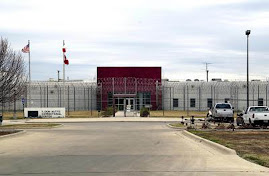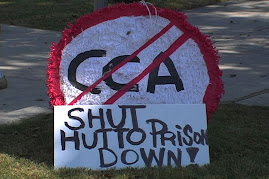From Houston Chronicle: ICE will revamp detainee system, policy of using converted prisons to hold families of illegal immigrants is on its way out
Three years ago, immigrant families sent to a Central Texas immigration detention center found themselves at a converted prison rimmed in razor wire. Child inmates slept with their parents in cells monitored by lasers, stood still for daily head counts and donned navy detention uniforms available in sizes as small as infant onesies. They reported getting only one hour of school a day and going weeks without playing in the sun.From the San Antonio Express-News: Detention overhaul hits Austin area site
As word spread about conditions for families at the T. Don Hutto Family Residential Facility, critics pointed to the former medium-security prison as being emblematic of problems associated with the Bush administration's immigration detention practices. ...
The detention centers have been sharply criticized in recent years amid reports of substandard medical care, detainee deaths and poor access to attorneys. Morton said the system will be revamped to get away from a penal detention model that relies heavily on contracts with correctional facilities and private industry. Within the next three to five years, he said, the agency aims to use facilities designed, located and operated specifically for immigration purposes.
“What we're trying to do is design a system that reflects the unique civil detention authorities that we're exercising,” Morton said. “The population that we detain is different than the population that is detained in a traditional prison or jail setting.” ...
Barbara Hines, an attorney who oversees the University of Texas immigration law clinic and was one of the first nonprofit attorneys to visit the Hutto facility, praised ICE's addition of monitors to oversee daily operations at larger immigration facilities.
“Having ICE monitors in prisons is a good step forward because I think in the last couple years, the expansion of detention has gotten out of control, leading to deaths and a lack of medical care,” Hines said. “But I don't think ICE is capable of policing itself.” ...
Morton stressed that ICE is not shying away from immigration detention in general. “We are going to continue to detain people, and we are going to continue to detain people on a large scale,” he said.
Several years ago, the Bush administration hailed the 512-bed Hutto facility as a model center, which was operated under contract by Corrections Corp. of America.
However, a federal lawsuit filed by the American Civil Liberties Union forced the Bush administration to make improvements to the former state prison and to make it more family-friendly.
But civil rights groups and immigrant advocacy organizations continued to call conditions at the Texas center deplorable.
“Ending family detention at Hutto is extremely welcome and long overdue,” said Joanne Lin, ACLU legislative counsel.
The ACLU said it would continue to push for reform of the immigration detention system to ensure detainees are given access to due process and not inappropriately locked up for prolonged periods of time.
[what your representatives REALLY think] Congressional Republicans, meanwhile, questioned whether the detention system changes would be a return to the controversial catch-and-release system that was ended by the creation of the detention facilities under the Bush administration.
Alternatives to detention, like supervised release and catch-and-release programs, for immigrants scheduled to be deported do not work, said Rep. Lamar Smith, R-San Antonio and the ranking Republican on the House Judiciary Committee, which oversees immigration law.
“I hope that the Obama administration will not repeat past mistakes and return to a policy that puts more illegal immigrants on the streets of American communities,” Smith said.
From the LA Times: Obama aims to overhaul immigration jail system
Pledging more oversight and accountability, the Obama administration announced plans Thursday to transform the nation's immigration detention system from one reliant on a scattered network of local jails and private prisons to a centralized one designed specifically for civil detainees.
The reforms are aimed at establishing greater control over a system that houses about 33,000 detainees a day and that has been sharply criticized as having unsafe and inhumane conditions and as lacking the medical care that may have prevented many of the 90 deaths that have occurred since 2003. ...
Immigrant rights advocates welcomed the changes but said there was still no clear policy on how detention facilities would be penalized if problems were found.
"We are encouraged that the administration is taking a hard look at what has traditionally been a dark spot in our immigration system," said Karen Tumlin, a staff attorney at the Los Angeles-based National Immigration Law Center. "However, only time will tell if the reforms announced today amount to lasting change or simply creative repackaging of prior policies."
Tumlin and others said the detention standards needed to be made legally binding to guarantee immigrants access to counseling, family visits, legal materials and recreation time. Legislation has been introduced aimed at accomplishing this.
Advocates also said that the government should use less punitive and less costly alternatives to detention, such as ankle bracelets or intensive supervision, for certain immigrants.
"We are very disappointed by the failure to discuss alternatives to detention in the proposal," said Ahilan Arulanantham, an attorney at the American Civil Liberties Union of Southern California. "The system now detains thousands of people who are not a danger and not a flight risk."
To increase oversight, the immigration agency would place federal monitors in 23 large facilities, which house more than 40% of the detainees. The agency also plans to hire experts in healthcare administration and detention management, and someone to review medical complaints.
"We need a system that is open, transparent and accountable," Morton said.
A crackdown on illegal immigrants under the George W. Bush administration led to a dramatic increase in the detainee population, from 19,700 in fiscal year 2006 to 33,400 today. The budget for detention and deportation is nearly $2.5 billion, much of which is spent on contracts with private prison companies such as Corrections Corp. of America.
Morton said the agency did not plan to reduce the number of detainees or stop contracting with local governments and private corporations. But he said his staff would assess where detainees should be housed.
He said that many -- including some asylum seekers and those without criminal records waiting to be deported -- should be in facilities less restrictive than jails and prisons.








